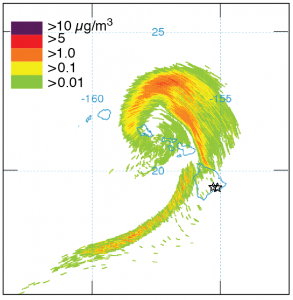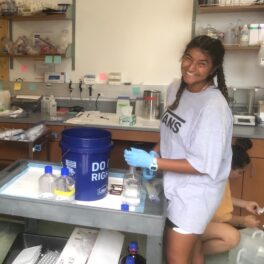New research reveals vog’s effects on Hawai‘i’s weather
 Model predictions show Kilauea emissions entrained in Tropical Storm Flossie (Pattantyus and Businger; 2014).
Model predictions show Kilauea emissions entrained in Tropical Storm Flossie (Pattantyus and Businger; 2014).One might assume that a tropical storm moving through volcanic smog (vog) would sweep up the tainted air and march on, unchanged. However, a recent study from atmospheric scientists at SOEST revealed that although they are microscopic, gasses and particles from Kilauea volcano exerted an influence on Tropical Storm Flossie — affecting the formation of thunderstorms and lightning in the sizable storm. “We have a lightning detection network. We found when the vog plume was entrained in the deep clouds associated with Flossie, there was a great enhancement of lightning,” said Atmospheric Sciences professor Steven Businger, co-author with graduate assistant and lead author Andre Pattantyus of the paper in Geophysical Research Letters.
UPDATES regarding Hurricanes Iselle and Julio: an interview with Businger at Hawaii New Now and an article at Smithsonian.com. Watch the video interview with Businger at Hawaii News Now; read more about it at KITV4, West Hawaii Today, Reporting Climate Science, and in the UH System News. Image courtesy of Pattantyus and Businger.




